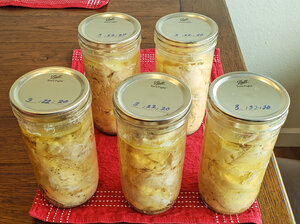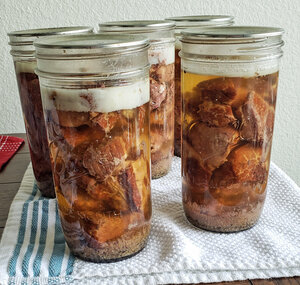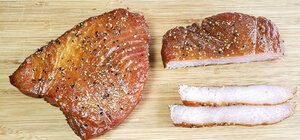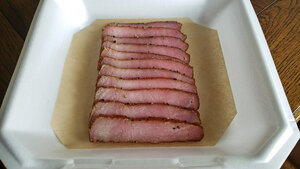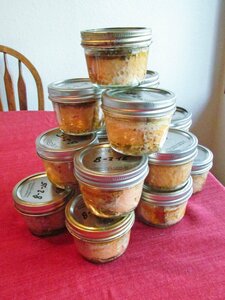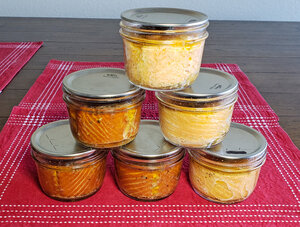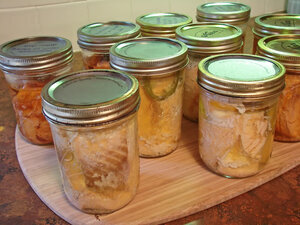I’ve been a trout fisherman my entire life. I like the sport, and I like the bounty. Fried, baked, grilled, smoked….it’s all good. Each member of the trout and salmon family is slightly different, and I like them all. But there is one cooking method I use that is not as common as the others…. pressure canning. Here is how I do it. I'm going to assume you understand how to use a pressure canner , what pressure (PSI) or weight of rocker to use for your elevation, and the general procedures for preparing the jars.
First, some background information: The authorities on pressure are the USDA, National Center for Home Food Preservation, and various University or State Extension Services. Companies like Ball, Kerr, (now owned by Jarden) and a few others have published canning guides for years. Manufacturers of pressure canners also publish guides specific to their products, usually with some starter recipes. There are many online pressure canning websites, some are very good, and some are not. One of the good ones is healthycanning.com because they reference specific sources in their articles, and do a great job when presenting and explaining information. Secondly, it’s important to note that the USDA did research and developed recommendations for on pressure and water bath canning from the 1930’s through the 1950’s. Then, in the 1980’s they did a review of the recommendations. This somewhat outdated information is the foundation for all canning procedures and recipes used today. When it comes to canning questions and concerns the 'official position' is that research-based information was used to give the public recipes that were guaranteed safe, and until more testing is conducted.... variations to tested recipes, or creating new recipes is not recommended. In more recent years, had researchers in Alaska and Oregon not done testing on canning smoked salmon, even that would be off limits as salted and smoked salmon was considered 'cured' meat, which was not tested by the USDA.
Here are examples of both fresh and smoked steelhead.



Canning FRESH FISH in the salmon family: Keep your fresh caught fish on ice, and if using store bought fish buy the freshest you can. The majority of the recipes you will see recommend pint or 1/2 pint jars because of the density of fresh fish. Using jars larger than a pint may not heat thoroughly during processing. Processing time is 100 minutes for either size of jar. I use wide mouth 1/2 pint jars. And here is the recipe I use.
Ingredients for canning FRESH FISH:
1/2 pint jars, lids and rings
Fish, boneless, skin-off, cut into strips about 1” shorter than the jar height
Bottled water
Garlic pepper seasoning
Seasoned salt
Black pepper, coarse or cracked
Jalapeno peppers, cut into 1/4" rings. Remove seeds for a milder flavor
Olive oil
Load your jars as follows: (You need to maintain 1” of head space in the jar.)
1. Jalapeno ring
2. Pinch of black pepper
3. Strips of fish
4. A second jalapeno ring (or some red onion)
5. 1/4 teaspoon of garlic pepper
6. 1/4 teaspoon seasoned salt
7. 1/2 tablespoon of bottled water*
8. 1/3 teaspoon of olive oil*
*Canning procedures for raw meats (called raw pack) of all kinds say “do not add liquids to the jars”. This is because none of the procedures tested by the USDA used additional liquid in the jars. Many procedures state that fish canned in 1/2 pint jars “may be less acceptable than fish canned in pint jars”. Confirm the recommended amount of water needed for your canner, but the amount is usually 3 quarts. When using 1/2 pint jars I will use some spare rings under the rack to raise the jars so they do not float. My canner allows for double decking 1/2 pint jars.
==================================
==================================
Canning SMOKED FISH in the salmon family: Keep your fresh caught fish on ice, and if using store bought fish buy the freshest you can. The majority of the recipes you will see recommend pint or 1/2 pint jars because of the density of lightly smoked fish. Using jars larger than a pint may not heat thoroughly during processing. Processing time is 110 minutes for either size of jar. It is recommended that 4 quarts of water are used in the canner. The processing time is increased, and more water used in the canner because the density of cured and lightly smoked fish is different than raw fish. I use wide mouth 1/2 pint jars. And here are the recipes I use.
Smoking your fish is all about flavor, and the smoking process firms the flesh slightly and produces a very light smoke flavor. The fish remains in a semi-raw state. This process will take 2 days. Day 1: I use a dry cure method with fish fillets wrapped in plastic wrap. Curing time is based on thickness, a trout fillet cures for 1 to 2 hours. Steelhead fillets cure for 3 to 4 hours, and thicker salmon fillets cure for 6 hours. The fish is rinsed, and soaked in water for 15 minutes, then placed on a tray on a rack and refrigerated overnight so it forms a pellicle before smoking. Day 2: Set up your smoker for cold smoking. Smoker temps of 80° or less are ideal. Remove the skin, and trim off the blood line if needed. Be very conservative with smoking times on your first batch. Smokey flavor is intensified during processing. Trout fillets may only need 60 to 90 minutes of cold smoke. Steelhead will need about 2 hours, and thicker salmon fillets need 2.5 to 3 hours. After cold smoking, return fillets to the refrigerator for a couple of hours to cool down. The fish is now ready for canning. If you wait until the next day to can your fish, just wrap in plastic.
This is the recipe for the dry cure I use. This makes enough cure for about 10 pounds of fish, so adjust accordingly. (This is the same cure I use for hot smoked salmon).
~thirdeye's~ Dry Cure For Salmon, Trout, and Steelhead
1 cup Mortons kosher salt (if you use Diamond Crystal, you will have to use more as it has larger grains)
2 cloves of garlic, finely chopped
2 cups firmly packed brown sugar
2 teaspoon ground ginger (I prefer to grind this myself in my mortar and pestle from cracked ginger)
1-2 teaspoons ground white pepper
1/2 teaspoon pulverized bay leaf
On a cutting board, sprinkle a little of the salt onto the chopped garlic, and mash to a paste with the point of a knife. In a small bowl, combine the garlic mixture with the remaining salt, the sugar, ginger, pepper and bay leaf. Mix this very well. Extra can be stored in the freezer.
Take a piece of plastic wrap at least 6 or 7 inches longer than your fillet and lay it out on your counter. In the center of the plastic, sprinkle a layer of cure about 1/8" to 1/4" deep onto the plastic wrap, making sure the layer of cure is a little longer and wider than your fillet. (You will be using the extra plastic on the ends when wrapping the fillet). Place one fillet on top of the cure (skin side up), then fold the sides up and then the ends, leaving the seam on top. The wrapped fillets can be stacked. (I put them on a shallow tray just in case one leaks). Put the fillets into the fridge to cure using the curing times above. While curing the dry cure turns into a syrup as liquids are pulled from the fish. Follow instructions above for rinsing, soaking and pellicle formation.


Fillets after rinse, soak-out and chilling overnight for pellicle formation. The flesh is slightly firm, dry and slightly sticky to the touch. With the somewhat short times of cold smoking, the appearance of the fillets will not change that much.

Ingredients for canning SMOKED FISH:
(There is no salt added to the jars because the cured fish has retained some saltiness, garlic powder is used because garlic pepper blends contain salt).
1/2 pint jars, lids and rings
Fish, cold smoked, boneless, skin-off, cut into strips about 1” shorter than the jar height
Bottled water
Garlic powder
Black pepper, coarse or cracked
Jalapeno peppers, cut into 1/4" rings. Remove seeds for a milder flavor
Olive oil
Load your jars as follows: (You need to maintain 1” of head space in the jar.)
1. Jalapeno ring
2. Pinch of black pepper
3. Strips of fish
4. A second jalapeno ring (or some red onion)
5. 1/8 teaspoon of garlic powder
6. 1/2 tablespoon of bottled water*
7. 1/3 teaspoon of olive oil*
*Canning procedures for raw meats (called raw pack) of all kinds say “do not add liquids to the jars”. This is because none of the procedures tested by the USDA used additional liquid in the jars. Many procedures state that fish canned in 1/2 pint jars “may be less acceptable than fish canned in pint jars”. Confirm the recommended amount of water needed for your canner, but the amount is usually 3 quarts. When using 1/2 pint jars I will use some spare rings under the rack to raise the jars so they do not float. My canner allows for double decking 1/2 pint jars.
First, some background information: The authorities on pressure are the USDA, National Center for Home Food Preservation, and various University or State Extension Services. Companies like Ball, Kerr, (now owned by Jarden) and a few others have published canning guides for years. Manufacturers of pressure canners also publish guides specific to their products, usually with some starter recipes. There are many online pressure canning websites, some are very good, and some are not. One of the good ones is healthycanning.com because they reference specific sources in their articles, and do a great job when presenting and explaining information. Secondly, it’s important to note that the USDA did research and developed recommendations for on pressure and water bath canning from the 1930’s through the 1950’s. Then, in the 1980’s they did a review of the recommendations. This somewhat outdated information is the foundation for all canning procedures and recipes used today. When it comes to canning questions and concerns the 'official position' is that research-based information was used to give the public recipes that were guaranteed safe, and until more testing is conducted.... variations to tested recipes, or creating new recipes is not recommended. In more recent years, had researchers in Alaska and Oregon not done testing on canning smoked salmon, even that would be off limits as salted and smoked salmon was considered 'cured' meat, which was not tested by the USDA.
Here are examples of both fresh and smoked steelhead.
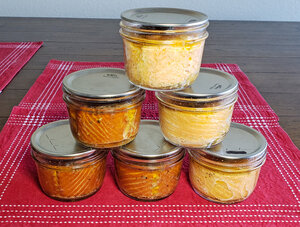
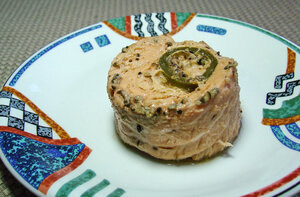
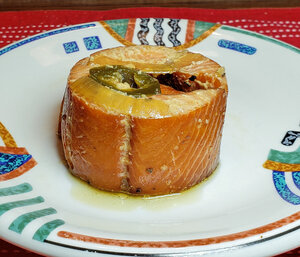
Canning FRESH FISH in the salmon family: Keep your fresh caught fish on ice, and if using store bought fish buy the freshest you can. The majority of the recipes you will see recommend pint or 1/2 pint jars because of the density of fresh fish. Using jars larger than a pint may not heat thoroughly during processing. Processing time is 100 minutes for either size of jar. I use wide mouth 1/2 pint jars. And here is the recipe I use.
Ingredients for canning FRESH FISH:
1/2 pint jars, lids and rings
Fish, boneless, skin-off, cut into strips about 1” shorter than the jar height
Bottled water
Garlic pepper seasoning
Seasoned salt
Black pepper, coarse or cracked
Jalapeno peppers, cut into 1/4" rings. Remove seeds for a milder flavor
Olive oil
Load your jars as follows: (You need to maintain 1” of head space in the jar.)
1. Jalapeno ring
2. Pinch of black pepper
3. Strips of fish
4. A second jalapeno ring (or some red onion)
5. 1/4 teaspoon of garlic pepper
6. 1/4 teaspoon seasoned salt
7. 1/2 tablespoon of bottled water*
8. 1/3 teaspoon of olive oil*
*Canning procedures for raw meats (called raw pack) of all kinds say “do not add liquids to the jars”. This is because none of the procedures tested by the USDA used additional liquid in the jars. Many procedures state that fish canned in 1/2 pint jars “may be less acceptable than fish canned in pint jars”. Confirm the recommended amount of water needed for your canner, but the amount is usually 3 quarts. When using 1/2 pint jars I will use some spare rings under the rack to raise the jars so they do not float. My canner allows for double decking 1/2 pint jars.
==================================
==================================
Canning SMOKED FISH in the salmon family: Keep your fresh caught fish on ice, and if using store bought fish buy the freshest you can. The majority of the recipes you will see recommend pint or 1/2 pint jars because of the density of lightly smoked fish. Using jars larger than a pint may not heat thoroughly during processing. Processing time is 110 minutes for either size of jar. It is recommended that 4 quarts of water are used in the canner. The processing time is increased, and more water used in the canner because the density of cured and lightly smoked fish is different than raw fish. I use wide mouth 1/2 pint jars. And here are the recipes I use.
Smoking your fish is all about flavor, and the smoking process firms the flesh slightly and produces a very light smoke flavor. The fish remains in a semi-raw state. This process will take 2 days. Day 1: I use a dry cure method with fish fillets wrapped in plastic wrap. Curing time is based on thickness, a trout fillet cures for 1 to 2 hours. Steelhead fillets cure for 3 to 4 hours, and thicker salmon fillets cure for 6 hours. The fish is rinsed, and soaked in water for 15 minutes, then placed on a tray on a rack and refrigerated overnight so it forms a pellicle before smoking. Day 2: Set up your smoker for cold smoking. Smoker temps of 80° or less are ideal. Remove the skin, and trim off the blood line if needed. Be very conservative with smoking times on your first batch. Smokey flavor is intensified during processing. Trout fillets may only need 60 to 90 minutes of cold smoke. Steelhead will need about 2 hours, and thicker salmon fillets need 2.5 to 3 hours. After cold smoking, return fillets to the refrigerator for a couple of hours to cool down. The fish is now ready for canning. If you wait until the next day to can your fish, just wrap in plastic.
This is the recipe for the dry cure I use. This makes enough cure for about 10 pounds of fish, so adjust accordingly. (This is the same cure I use for hot smoked salmon).
~thirdeye's~ Dry Cure For Salmon, Trout, and Steelhead
1 cup Mortons kosher salt (if you use Diamond Crystal, you will have to use more as it has larger grains)
2 cloves of garlic, finely chopped
2 cups firmly packed brown sugar
2 teaspoon ground ginger (I prefer to grind this myself in my mortar and pestle from cracked ginger)
1-2 teaspoons ground white pepper
1/2 teaspoon pulverized bay leaf
On a cutting board, sprinkle a little of the salt onto the chopped garlic, and mash to a paste with the point of a knife. In a small bowl, combine the garlic mixture with the remaining salt, the sugar, ginger, pepper and bay leaf. Mix this very well. Extra can be stored in the freezer.
Take a piece of plastic wrap at least 6 or 7 inches longer than your fillet and lay it out on your counter. In the center of the plastic, sprinkle a layer of cure about 1/8" to 1/4" deep onto the plastic wrap, making sure the layer of cure is a little longer and wider than your fillet. (You will be using the extra plastic on the ends when wrapping the fillet). Place one fillet on top of the cure (skin side up), then fold the sides up and then the ends, leaving the seam on top. The wrapped fillets can be stacked. (I put them on a shallow tray just in case one leaks). Put the fillets into the fridge to cure using the curing times above. While curing the dry cure turns into a syrup as liquids are pulled from the fish. Follow instructions above for rinsing, soaking and pellicle formation.
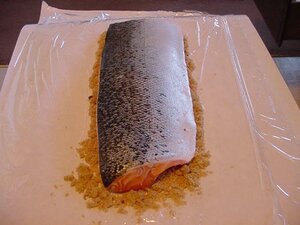
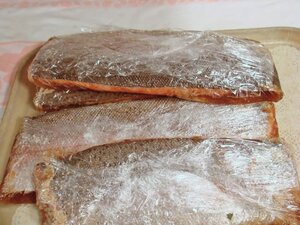
Fillets after rinse, soak-out and chilling overnight for pellicle formation. The flesh is slightly firm, dry and slightly sticky to the touch. With the somewhat short times of cold smoking, the appearance of the fillets will not change that much.
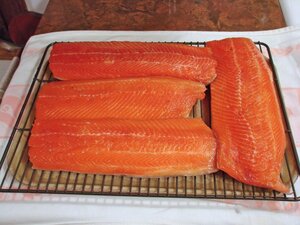
Ingredients for canning SMOKED FISH:
(There is no salt added to the jars because the cured fish has retained some saltiness, garlic powder is used because garlic pepper blends contain salt).
1/2 pint jars, lids and rings
Fish, cold smoked, boneless, skin-off, cut into strips about 1” shorter than the jar height
Bottled water
Garlic powder
Black pepper, coarse or cracked
Jalapeno peppers, cut into 1/4" rings. Remove seeds for a milder flavor
Olive oil
Load your jars as follows: (You need to maintain 1” of head space in the jar.)
1. Jalapeno ring
2. Pinch of black pepper
3. Strips of fish
4. A second jalapeno ring (or some red onion)
5. 1/8 teaspoon of garlic powder
6. 1/2 tablespoon of bottled water*
7. 1/3 teaspoon of olive oil*
*Canning procedures for raw meats (called raw pack) of all kinds say “do not add liquids to the jars”. This is because none of the procedures tested by the USDA used additional liquid in the jars. Many procedures state that fish canned in 1/2 pint jars “may be less acceptable than fish canned in pint jars”. Confirm the recommended amount of water needed for your canner, but the amount is usually 3 quarts. When using 1/2 pint jars I will use some spare rings under the rack to raise the jars so they do not float. My canner allows for double decking 1/2 pint jars.


